Webinars and Podcasts
This page features PSP-sponsored webinars and podcasts on topics of interest related to increasing public safety and reducing violence.
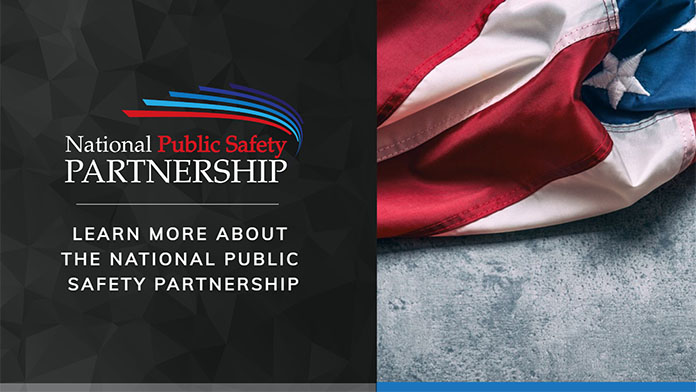
Learn More About PSP 2023 Webinar
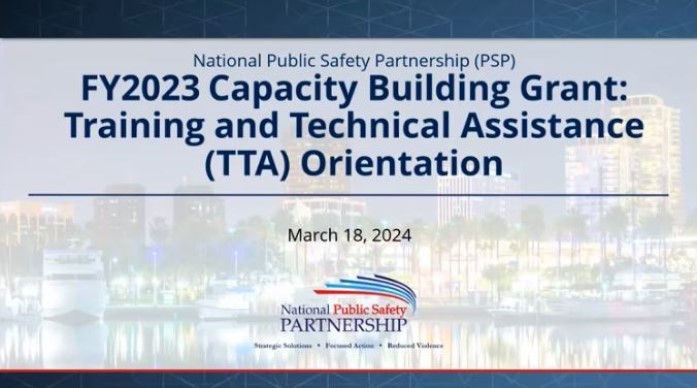
PSP Capacity Building Grant TTA Orientation
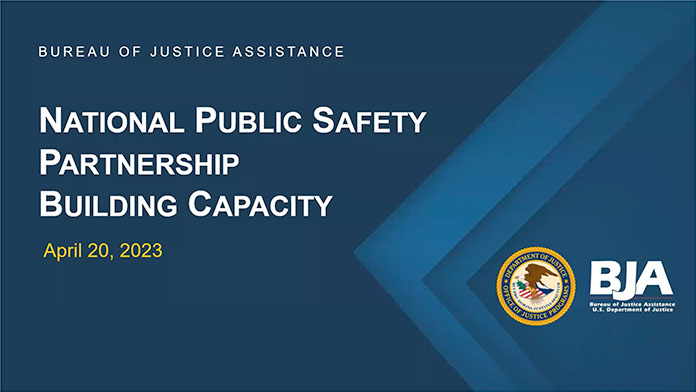
PSP Capacity Building Grant Webinar
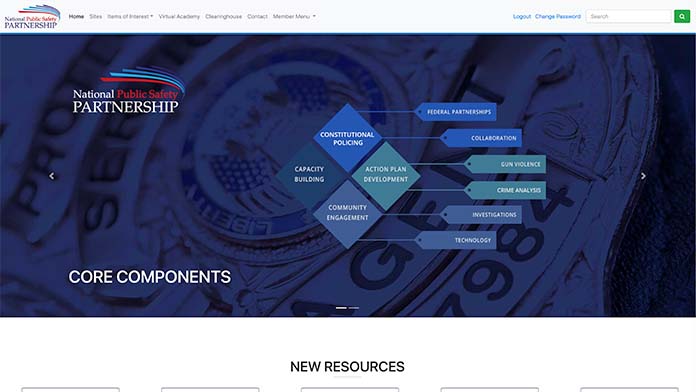
PSP Virtual Resources Web Event
On January 20, 2022, National Public Safety Partnership (PSP) leaders and team members welcomed the 2021 sites and provided an overview of the various virtual resources available to all participating PSP sites. The resources highlighted and demonstrated during the event include:
- The PSP Website (secure-access): Contains a plethora of on-demand webinars, podcasts, and other notable training and technical assistance (TTA) and access to newsletters and annual reports
- The Public Safety Clearinghouse and Mobile App: A one-stop shop for violence reduction and public safety resources from the U.S. Department of Justice
- Communities of Practice (CoP): PSP promotes CoPs to address shared challenges, needs, and lessons learned in PSP sites and in the broader criminal justice community
- The PSP Virtual Academy: Interactive, virtual courses available to participating sites on law enforcement topics identified to be of great importance and shared interest among the PSP network
- The Law Enforcement Training and Technical Assistance Consortium (LETTAC): A single, streamlined point of entry for Office on Violence Against Women (OVW) grantees and the field to request law enforcement TTA. The program assists all law enforcement in best responding to, investigating, and prosecuting intimate partner violence and Violence Against Women Act (VAWA) crimes.
In addition, attendees heard from CoP lead subject-matter experts Chief Sylvia Moir (Retired) (Law Enforcement Leadership), Ms. Laura McElroy (Public Information Officers), and Ms. Beth McGarry (Prosecution) on the benefits of active CoP participation and sharing lessons learned with colleagues nationwide.
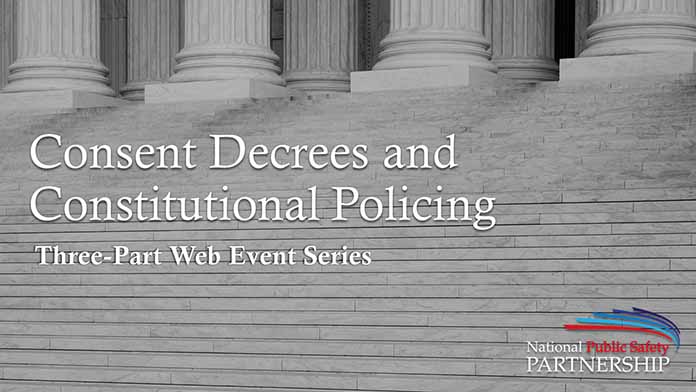
Consent Decrees and Constitutional Policing
The Bureau of Justice Assistance, the National Public Safety Partnership, and TacLogix Inc. present on-demand viewing of the three-part Web series on what agencies can learn from consent decrees, constitutional policing strategies, and successful police reform initiatives. The three sessions featured several notable guests and were moderated by Mr. Arif Alikhan, former Director of Constitutional Policing and Policy for the Los Angeles Police Department and U.S. Department of Justice official, and Geoffrey Alpert, Ph.D., professor, and independent monitor and police researcher, from the University of South Carolina’s Department of Criminology and Criminal Justice.
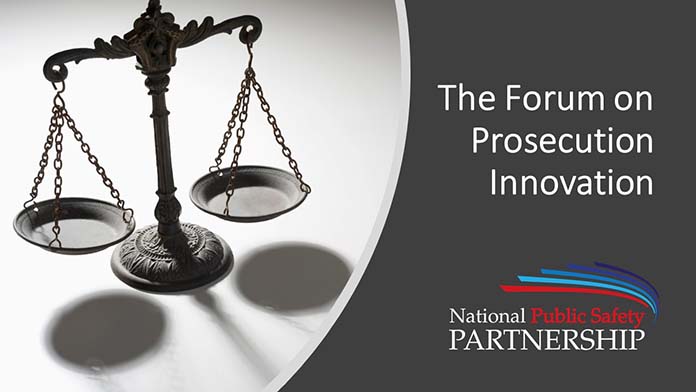
The Forum on Prosecution Innovation
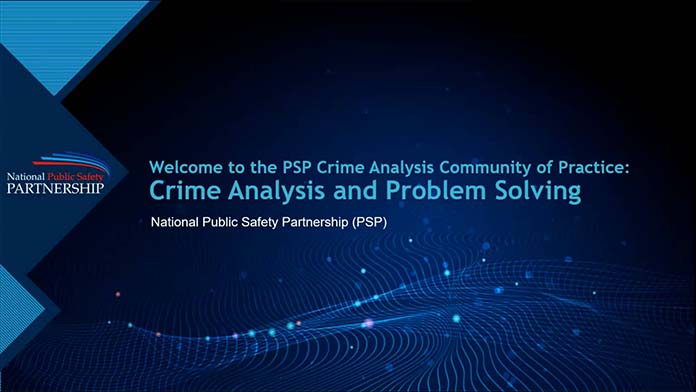
Crime Analysis Community of Practice—Crime Analysis and Problem Solving
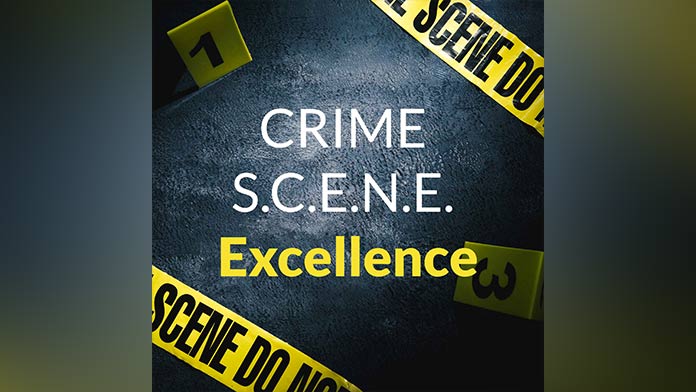
Crime S.C.E.N.E. Excellence Podcast
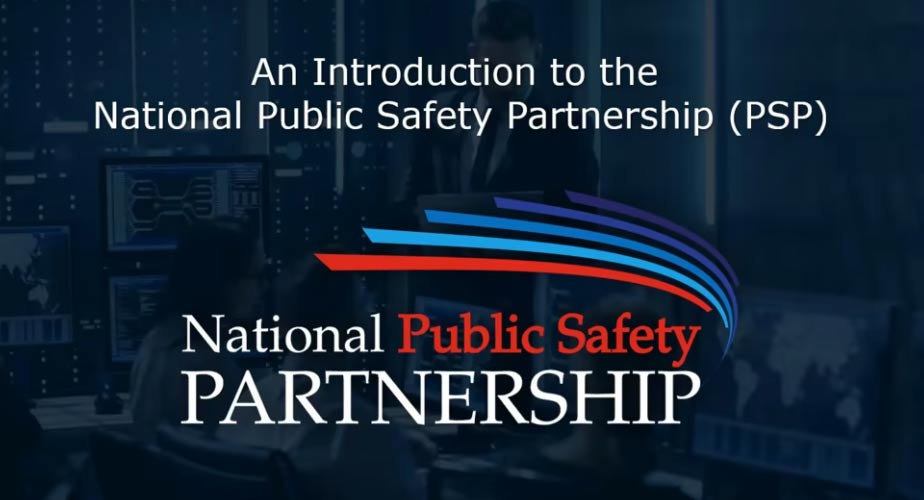
An Introduction to the National Public Safety Partnership
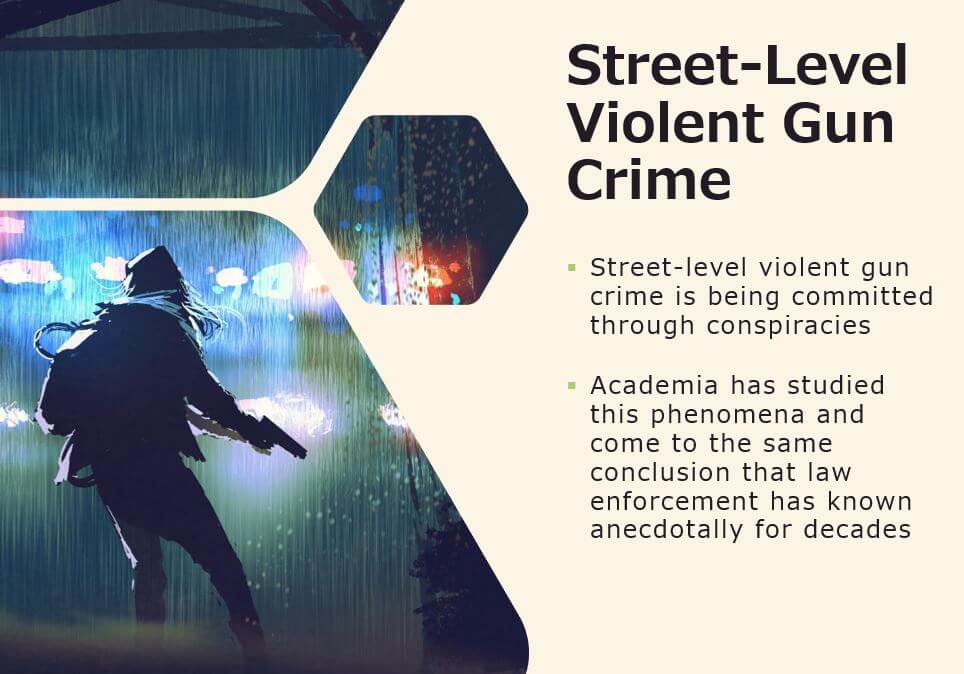
Innovative Strategies for Investigating Criminal Organizations
Street-level violent gun crime has two consistent, demographic features: a small percentage of a city’s population is responsible for an overwhelming majority of its violent gun crime and this small population operates in groups. Yet, in violent gun crime investigations and prosecutions, it is most often the single event and the single suspect that are in focus. This focus may overlook what is known and often leaves criminal organizations participating in violent gun crime free from accountability.
The National Integrated Ballistic Information Network (NIBIN) further reveals the group aspect to violent gun crime by showing a pattern of criminal behavior shootings. A more complex, but effective, approach to investigating individuals working together to engage in a pattern of violent gun crime is through conspiracy. This webinar explores the surface issues, applying conspiracy strategies to violent gun crime. It opens a discussion for thought to move toward innovative solutions.
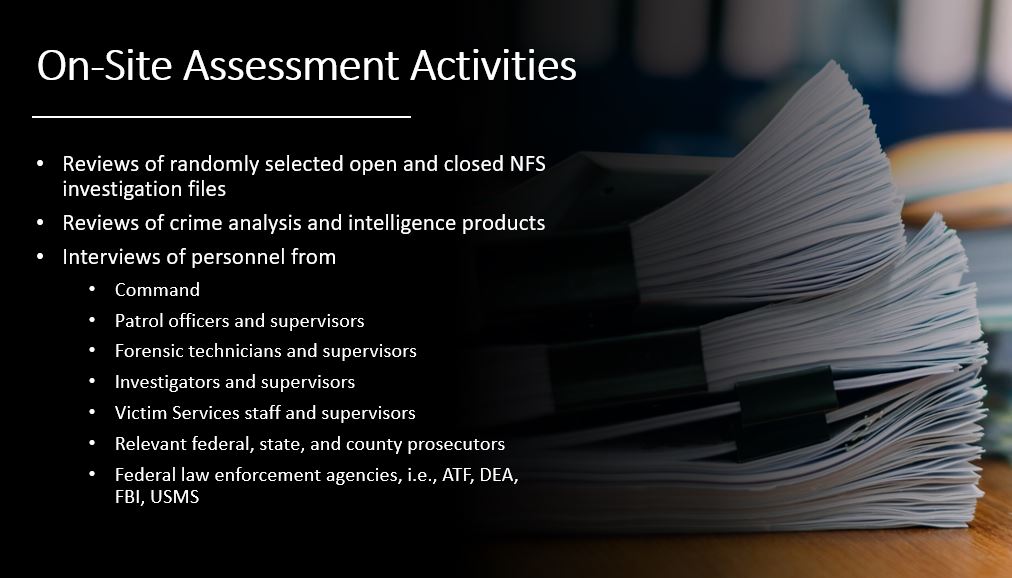
NFS Investigation Assessments: Observations From the Field
PSP provides the opportunity for PSP sites to receive an independent assessment of their nonfatal shooting (NFS) processes and protocols. These assessments are intended to provide the sites with a basis to increase their clearance rates, reduce violent offenses, enhance public safety, and decrease crime guns in circulation. In partnership with the Bureau of Justice Assistance, the Institute for Intergovernmental Research (IIR) fields an accomplished team of subject-matter experts to review and assess the requesting agency’s policies, procedures, and practices. This webinar highlights commonalities found in NFS investigation assessments conducted by IIR and provides a generic overview of related observations.

Lunch and Learn: Operation Save A Casing
This PSP Lunch and Learn event highlighted the Wichita, Kansas, Police Department’s Operation Save a Casing initiative, a Bureau of Justice Assistance-sponsored program that allows for local residents of a community to provide critical ballistic intelligence to law enforcement in the event that their firearms are stolen or lost. This event provided an overview of the program and its implementation by the Wichita Police Department.
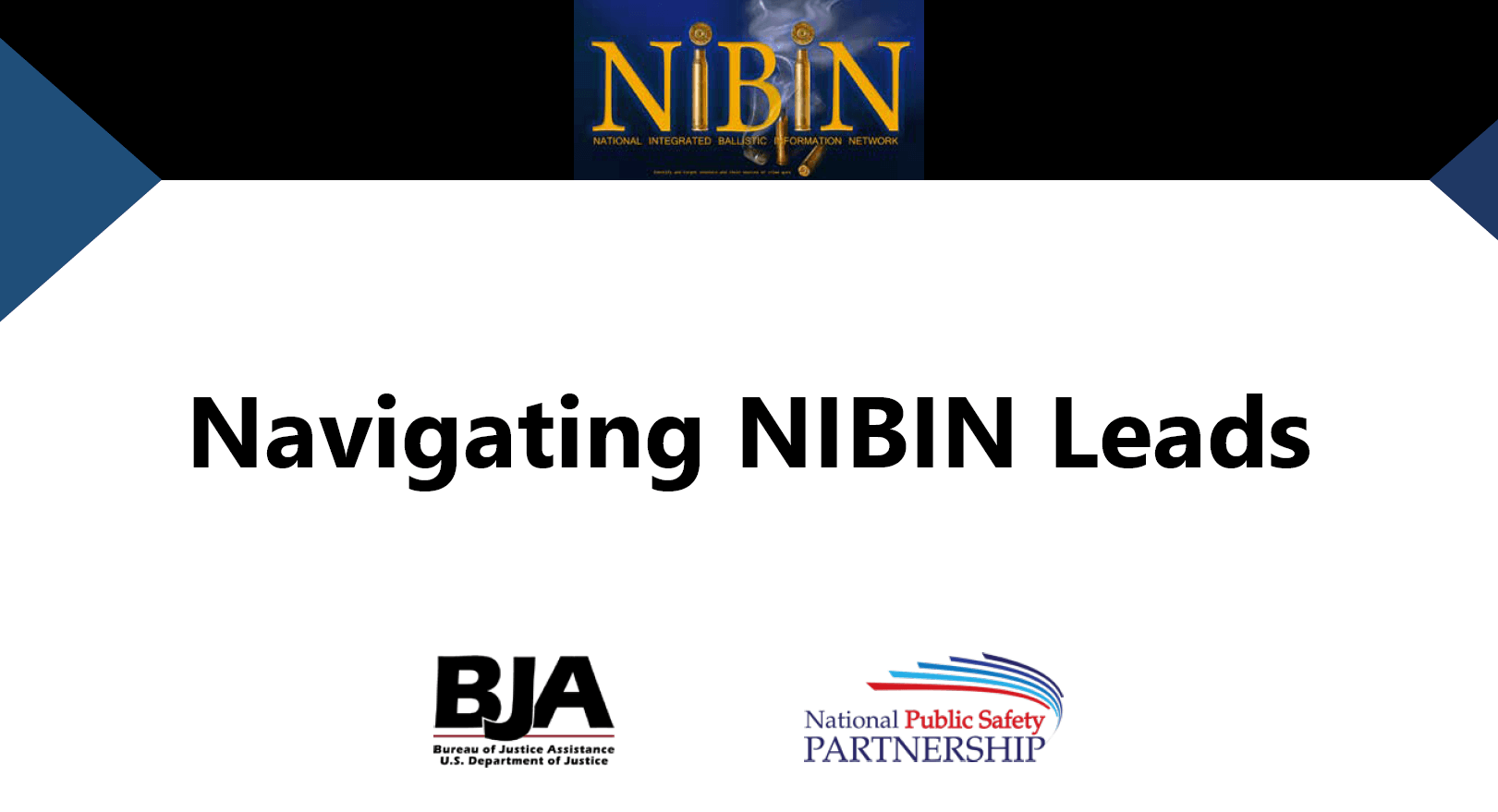
Navigating NIBIN Leads
The National Integrated Ballistic Information Network (NIBIN) is a useful, evidence-based tool for law enforcement’s fight against violent gun crime. As NIBIN continues to expand, more law enforcement agencies are able to take advantage of its important information. With that expansion, however, comes an increase in leads developed by NIBIN, often overwhelming departments and law enforcement in a region. Determining the investigative potential of these leads through effective triage is a critical piece to any successful NIBIN program.
This webinar featured a standardized and highly effective approach to accomplish NIBIN lead triage in a very short amount of time. Using geography, events, time, and solvability factors (GETS), departments are able to systematically triage NIBIN leads, saving hundreds of hours of criminal intelligence and investigative resource expenditures.
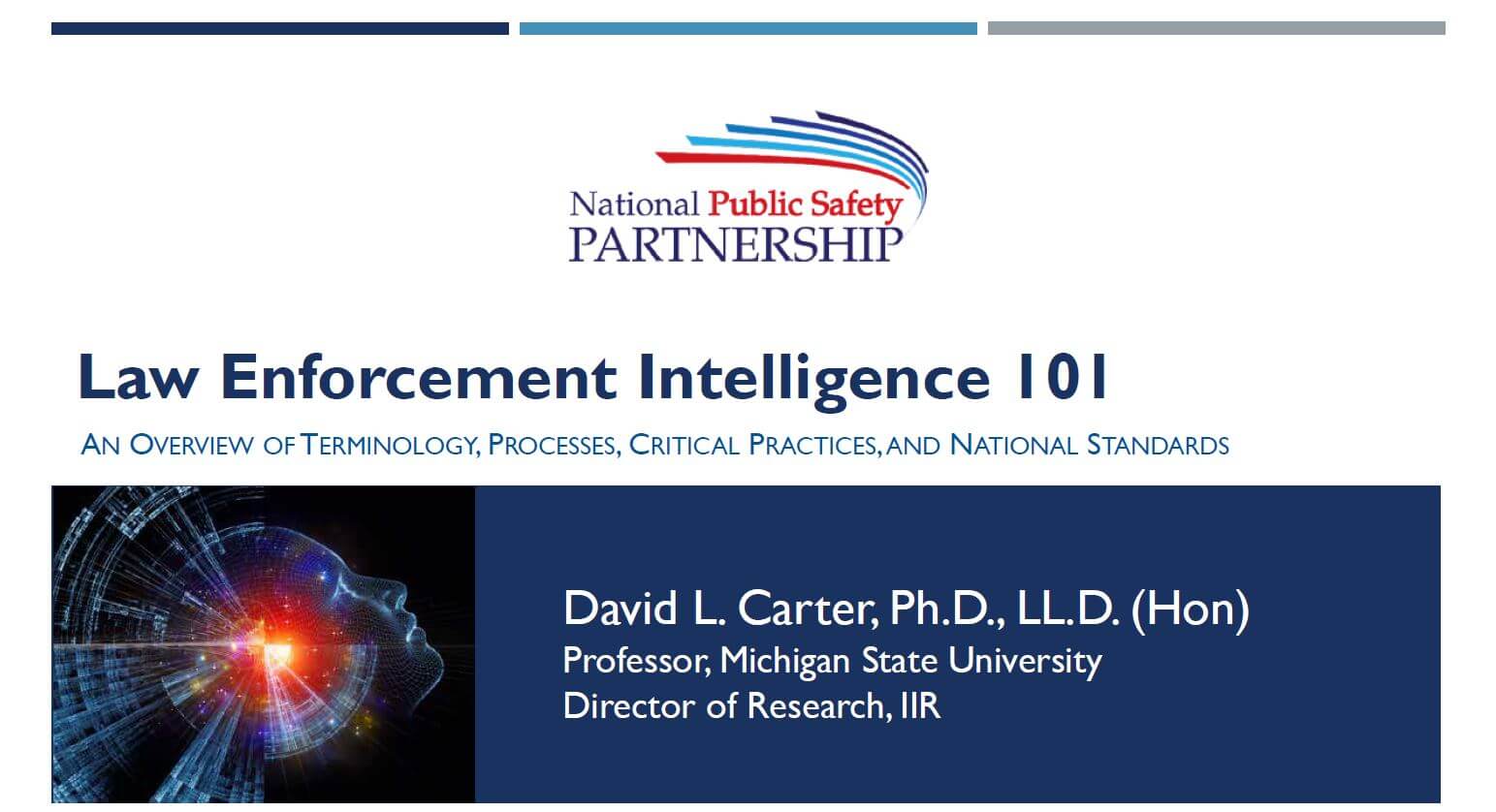
Intelligence 101
In today’s climate of rapidly evolving technology, intense public scrutiny, and the increased availability of data to drive strategies, it has become increasingly important that violence reduction strategies are intelligence-led. This webinar provided PSP sites with an overview of the terminology associated with intelligence, as well as the review process required to utilize it in a manner that is both efficient and legal. In addition, the Intelligence 101 webinar highlighted critical practices and reviewed national standards that line officers and investigators need to know to combat violent crime, gangs, and criminal enterprises.
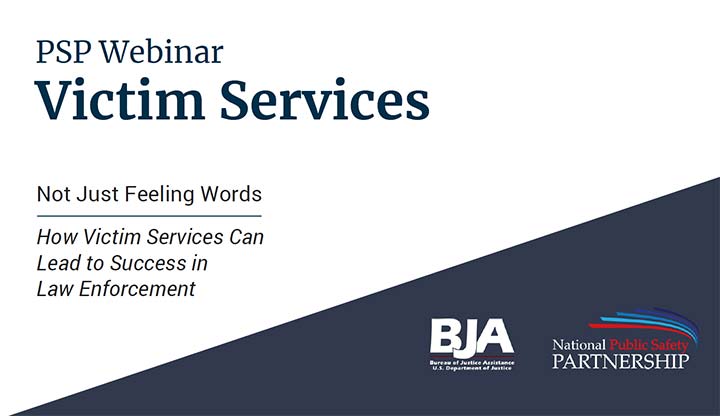
Model Victim Services
Integrating victim services into law enforcement agencies can provide crime victims with streamlined access to counseling and resources. In addition to providing more empathetic services to victims of crime, law enforcement agencies and prosecutorial partners benefit from enhanced victim/witness communication, which in turn can increase the likelihood of cooperation as cases progress through the criminal justice system. Implementing a victim services program can increase an agency’s ability to connect with the community they serve, however the process of building capacity in victim services can be a challenging endeavor. This webinar highlighted the implementation of a victim services program in the Chattanooga, Tennessee, Police Department and the Office for Victims of Crime’s law enforcement and victim services portfolio.
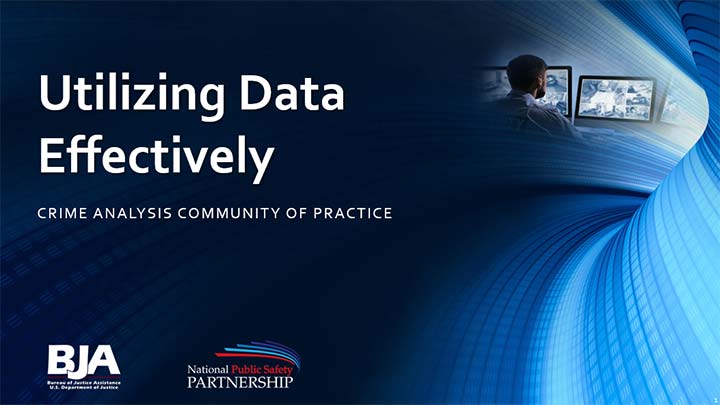
Utilizing Data Effectively
The 21st-century crime analyst’s role is ever-changing as technology continues to grow, evolve, and successfully support criminal investigations. Crime analysts are responsible for producing more than just dots on a map, charts, and graphs. The amount of data that is available to an analyst can be overwhelming, but knowing how to use data as a valuable tool for law enforcement can be a game changer. Topics addressed during this webinar included capturing, analyzing, and acting on data; critical thinking and becoming investigative in analyzing crime; utilizing the analyst network; and investigative resources and analytical case studies.
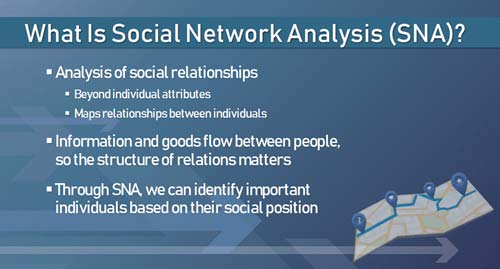
Social Network Analysis
Social network analysis (SNA) can be a useful tool for criminal investigations and police community efforts to reduce violent crime. Understanding how data is compiled and structured, how it may be utilized, and the limitations that it has is critical for leaders considering the use of SNA. This webinar outlined the concept of SNA and how this tool can be utilized to further crime-reduction strategies. Topics included visualizing a network and types of network data related to SNA, understanding group dynamics and the utilization of SNA in focused deterrence, SNA associated with hotspots as well as NIBIN linkages, and potential implementation challenges and legal considerations.
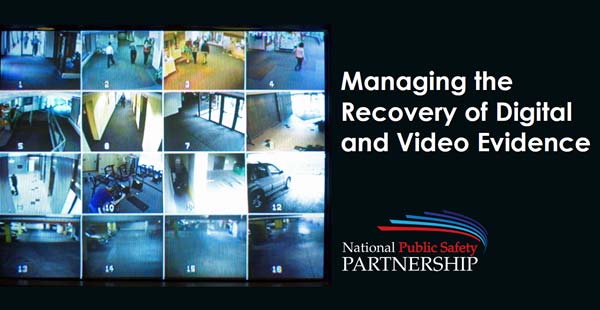
Managing the Recovery of Digital and Video Evidence
As video camera and cellular technology has advanced, digital and video evidence recovery has become critical to a successful criminal investigation. The proliferation of privately and publicly owned video cameras presents an unprecedented opportunity to build stronger cases supported by extensive digital evidence. The advancement and abundance of digital and video evidence have also presented new challenges to law enforcement and prosecutors who are now trying to recover, manage, and prepare large amounts of data and video evidence for trial. The Chicago, Illinois, Police Department (CPD) has recently established several Area Technology Centers (ATCs) and has integrated select personnel into these units to augment CPD’s investigative and patrol personnel in the recovery of digital evidence. Topics addressed during this webinar included: an outline of the ATC’s organizational structure, methods of deployment, and response protocols; technology utilized to capture digital evidence within the ATC; and CPD’s digital evidence recovery efforts, including case-specific summaries.
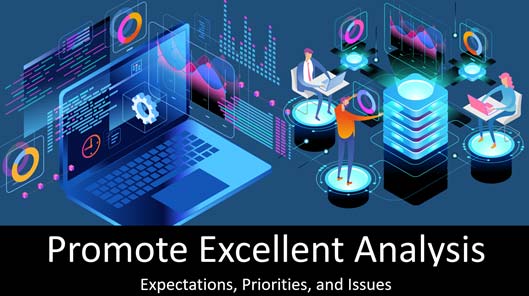
Crime Analysis for Executives
Crime analysis has become an essential tool in law enforcement’s efforts to enhance public safety, identify emerging trends, allocate resources, apply new technology, and plan crime-prevention strategies. Successful data-driven strategies such as hot-spot policing, problem-oriented policing, and intelligence-led policing use the work of an effective crime analysis unit. This webinar provided insight on how a crime analyst can support chiefs, sheriffs, and other police executives or managers with strategic or tactical decision making. Topics included: what to expect from your crime analyst, and how to make effective use of crime analysis; supporting and managing crime analysts, as well as staffing levels and placement; methods to improve data quality, including necessary tools and training; and Records Management System (RMS) and Computer-Aided Dispatch (CAD) connectivity.

Focused Deterrence
Focused-deterrence initiatives commonly include such aspects as identification of prolific offenders, scripted offender notification meetings, coordinated and strategic prosecution, provision of social services to individuals willing to accept them, and careful monitoring of individuals’ actions. When carefully and properly implemented, focused-deterrence initiatives have great potential to enhance the perceived legitimacy of the police and the public’s trust in them in communities where these have often been lacking. This webinar provides an introductory overview of the fundamentals of focused deterrence, research on and implementation of focused deterrence in major cities, and virtual tools to further focused deterrence efforts.
Please note, due to technical difficulties with the audio service provider during this presentation, viewers may experience minor audio impairments when viewing this webinar. For questions regarding this webinar or the topic of focused deterrence, please contact info@pspartnership.org.

Crime Guns 101
The initial recovery and identification of a crime gun is one of the most critical steps in any investigation. This step is even more critical for agencies whose communities are experiencing high incidences of violent gun crime, are expanding their utilization of crime gun intelligence (National Integrated Ballistic Information Network [NIBIN] and the Bureau of Alcohol, Tobacco, Firearms and Explosives’ [ATF] eTrace), or are participating in a Crime Gun Intelligence Center (CGIC). These firearms provide valuable investigative leads and are subsequently scrutinized during all aspects of the investigation that follows the recovery. Despite the importance of this initial step, few officers receive training on the identification of firearms and, as a result, firearms are frequently misidentified, leading to missed opportunities for lead development, case connection, and successful prosecution. This webinar provided an overview of the NIBIN process and CGIC concept, history and relevance of ATF’s eTrace, how to properly identify and recover crime guns, and lessons learned and successes from unique cases.
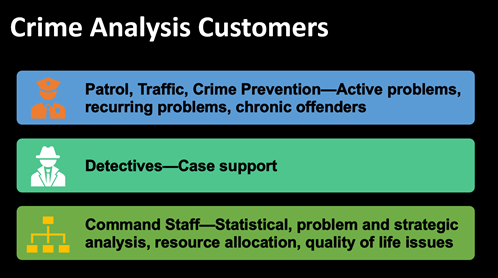
Basic Principles of Crime Analysis
Before crime analysts can become effective within their agencies, they must first build an analytical foundation built on basic principles. This presentation assisted participants in establishing a solid base as well as producing information and products that are useful to command staff members, patrol, and detectives. This presentation focused on defining the crime analyst’s role and building a solid analytical foundation, effective and actionable crime analysis products, and time management and prioritization of high vs. low priority products and services. Analytical case studies were also reviewed during this presentation.
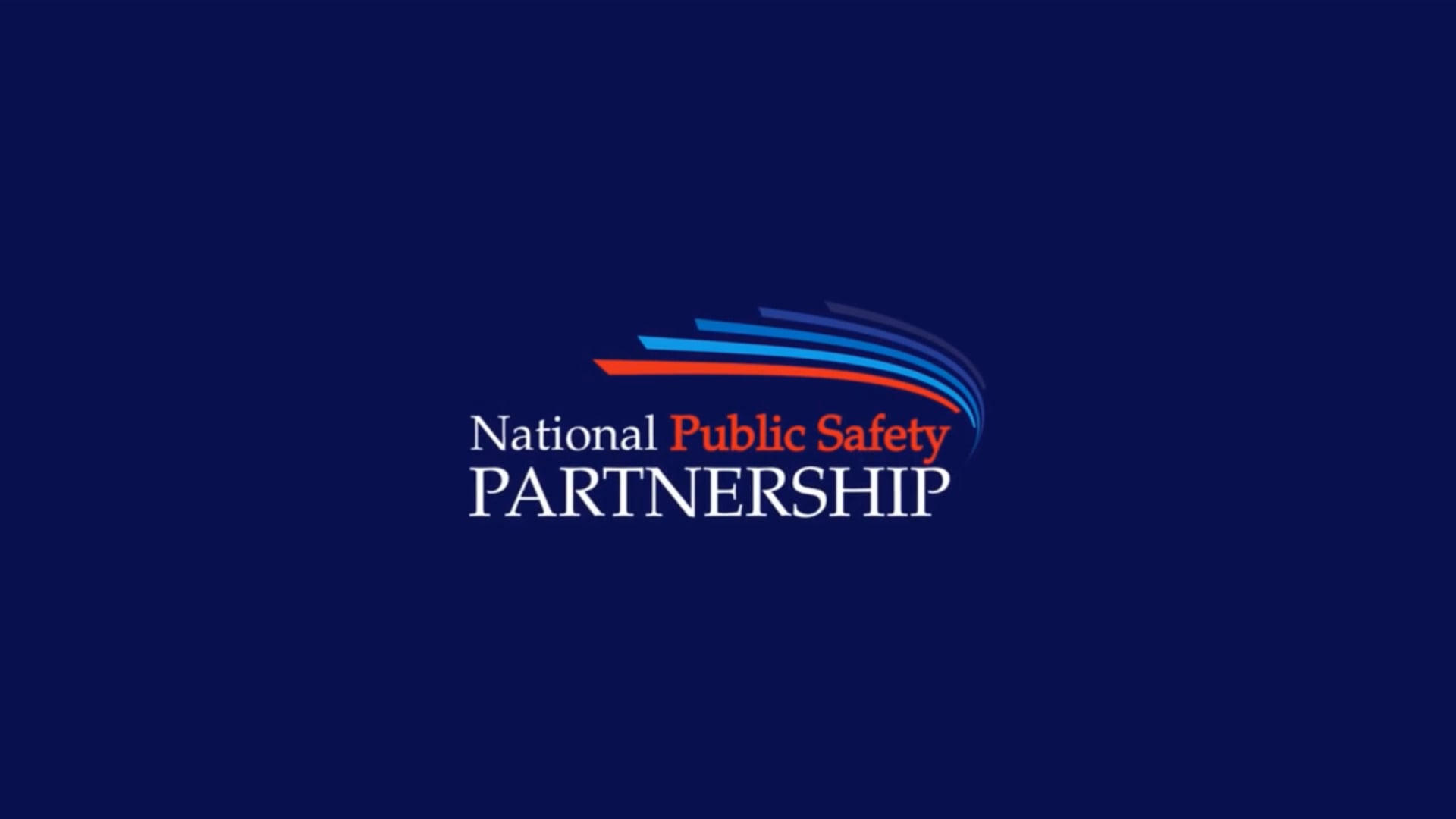
Video Podcast - On PIO Patrol
Nationally known Communication Consultant Laura McElroy hosts the brand new National Public Safety Partnership (PSP) Public Information Officer Community of Practice (PIOCoP) podcast titled "On PIO Patrol." On this debut episode, Laura welcomes Christopher Cook, Police Chief and Public Safety Director of White Settlement, Texas to discuss strategies and suggestions for effectively creating social media and local media with limited staff and budget.
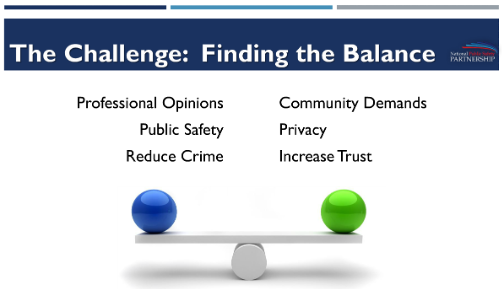
Digital Trust
Heading further into the 21st century, digital ethics and trust have become increasingly important issues for police. Communities and agencies are beginning to demand the collection of data and the analysis produced from its collection. Law enforcement agencies are also expected to utilize the data analysis and technology in a secure and ethical manner. The injudicious use of data, analytics, or technology by a police department may have a negative impact on public trust and may increase the difficulty of achieving effective policing in contemporary law enforcement. Leaders within law enforcement agencies will benefit from a deeper understanding of digital trust and its implications to their organizations and profession. This webinar explored the importance of building digital trust in law enforcement agencies. Digital trust between the police and their stakeholders allows for the use of promising technology while mitigating risks associated with the implementation and use of this technology.
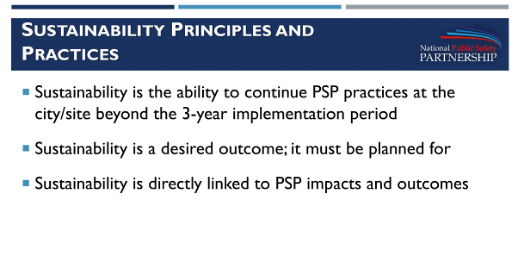
Sustainability Presentation by 2016 PSP Sites
This webinar served as an opportunity for PSP sites to learn about sustainability practices, accompanied by real-world examples. This webinar provided an introduction to sustainability principles and featured presentations by five PSP sites to share background on their PSP engagement and their plans for sustaining PSP and continuing to address violence in their communities.
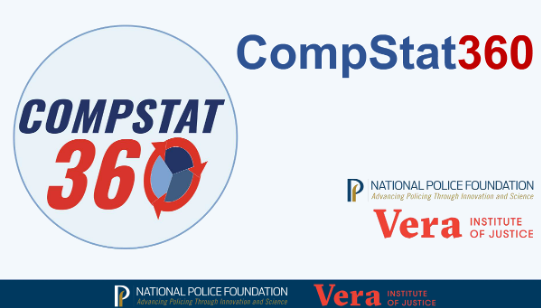
CompStat360
Through the CompStat360 Model, the Police Foundation and the Vera Institute of Justice are leading an effort to harness the power of CompStat in a new tool that provides police with a more complete picture of public safety and enables departments to make decisions based on community needs and priorities. As the adage goes, what gets measured matters. However, community metrics, which are key to ensuring that police respond to community safety needs, are often not measured to the same extent as crime. CompStat has proved to be a valuable tool in modern policing, and adding community measures can enhance the adoption of community policing and the coordinated response to public safety. CompStat360 offers an opportunity for police agencies to focus on crime as well as community engagement and organizational effectiveness. This webinar highlighted lessons learned from CompStat360 pilot sites, how PSP sites can incorporate these concepts, and how to request assistance.
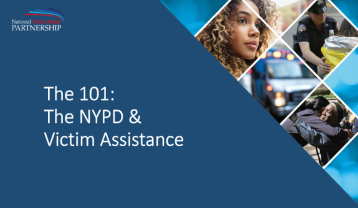
The 101: The NYPD and Victim Assistance
Over the course of five years, the New York Police Department (NYPD) has worked diligently to enhance the ways in which it can serve and respond to victims of crimes. At the onset of the adopted program, the NYPD asked its executive leadership to survey all bureaus and offices within the department, asking two vital questions: how do officers interact with victims of crimes, and how could those interactions be improved? Every function of the NYPD was examined in order to enhance its perceived response to victims of crimes. Input was also sought out from victim advocates and service providers through proactive interactions with these entities. This webinar provided an overview of the 101 ways in which the NYPD enhanced its response to victims of crime, the internal and external assessments that the NYPD completed to produce the initiatives currently in place, the Crime Victim Assistance Program that has been the cornerstone of the department’s efforts to improve its response to victims of crime, and the resources available through DOJ’s Office for Victims of Crime (OVC).
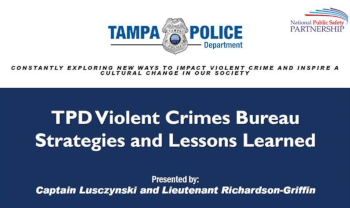
Tampa Police Department (TPD) Gun Crime Reduction Strategies
Since 2015, TPD has seen a 45 percent reduction in firearm related crimes, largely due to the success of TPD's new Violent Crimes Bureau (VCB). The VCB employs strategies such as integrating police units to create more centralized communication, identifying and focusing efforts and resources on the most violent offenders (the Violent Impact Players List), consistently identifying and targeting hot spots, implementing place-based policing and offender management tactics, engaging in effective federal partnerships, and relying on advanced technology such as the National Integrated Ballistic Information Network (NIBIN) and the gunshot detection system, ShotSpotter. This webinar will explore the TPD's VCB, including successes and lessons learned, specific gun crime reduction strategies and their effectiveness, and TPD's ideas for future improvement.
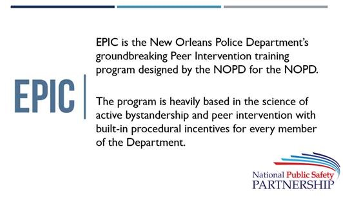
New Orleans Police Department (NOPD) Ethical Policing Is Courageous (EPIC) Peer Intervention Program
EPIC is a program developed by the NOPD in an effort to educate and support their officers in the practice of peer intervention. Through EPIC, the NOPD trains members of its department to identify and safely intervene when they believe a person is at risk for doing something that would harm themselves and/or others. This peer approach to 'policing' one another has proven to be effective for the NOPD in preventing harm and promoting officer wellness. The goal of this webinar is to highlight and bring awareness to this proactive, team-focused program as a solution to the officer safety issues that law enforcement faces today. This webinar will explore the efforts that went into gaining support for the program, steps for implementation, challenges faced, and lessons learned.
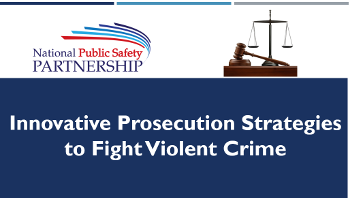
Innovative Prosecution Strategies to Fight Violent Crime
U.S. Attorneys play a vital leadership role for the PSP sites. Their unique position as law enforcement executives affords them the opportunity to effectively advance the PSP mission of reducing violent crime. The goal of this webinar is to highlight and bring awareness to some of the U.S. Attorneys' exceptionally successful and innovative efforts. Efforts that will be explored during this webinar include developing case review processes, directing and coordinating federal law enforcement assets to the violent crime hot spots within the community, effective goal setting, and developing and implementing innovative prosecution strategies that successfully combat violent crime.
Due to the sensitive nature of this Webinar, this recording is only available for DOJ representatives.Please contact us to request access to the recording.
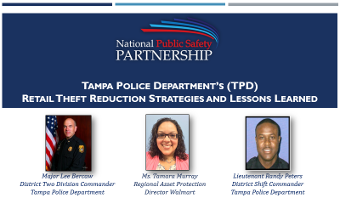
Retail Theft Reduction Strategies
In 2003, 18 percent of Tampa, Florida’s, retail theft was reported to the Tampa Police Department (TPD) by Walmart. The retailer had the highest percentage of shoplifting in the TPD’s jurisdiction—higher than the next four retail stores combined. The TPD and Walmart instituted a working partnership in an effort to mitigate the high rates of retail theft and reduce recidivism and calls for service. The purpose of this webinar is to highlight and bring awareness to this creative partnership/program as an option to fight crime.
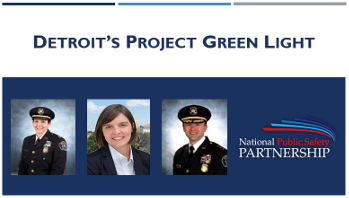
Detroit’s Project Green Light
Project Green Light is a public-private community partnership in Detroit, Michigan, aimed at improving neighborhood safety, promoting the revitalization and growth of local businesses, and strengthening the Detroit Police Department’s (DPD) efforts to deter, identify, and solve crime. Project Green Light began with eight gas stations that installed real-time camera connections with police headquarters. The DPD and the city devote staff to effectively receive, monitor, and analyze video feeds from Project Green Light partners, now integrated into Detroit’s Real Time Crime Center. Project Green Light businesses experienced an 11 percent reduction in violent crime in 2017 compared to 2016. This webinar will explore Detroit’s Project Green Light and lessons learned from the city regarding implementation of the project to reduce crime and violence. The webinar will also examine the rationale of the Project Green Light initiative; the implementation strategy; and some of the lessons learned, successes, and challenges.
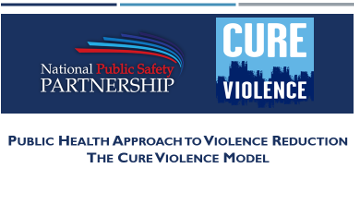
Public Health Approach to Violence Reduction—The Cure Violence Model
The Cure Violence Health Model applies the methodologies associated with the control of disease outbreaks: interrupting transmission of the disease, reducing the risk of the highest risk, and changing community norms. By viewing violence as contagious and treating it using a health approach, this model has proven effective in reducing violence in multiple jurisdictions across the country and internationally. The overall goal of this webinar is to educate through discussion how violence is an epidemic that can be prevented. This webinar will explore the science behind the Cure Violence Health Model and lessons learned from jurisdictions implementing the Cure Violence Health Model to reducing crime and violence. Make it Happen (Crown Heights, New York), a community-based violence reduction initiative is based on the Model. In the webinar, we will also examine the rationale of the Make it Happen initiative; the implementation strategy; and some of the lessons learned, successes, and challenges.
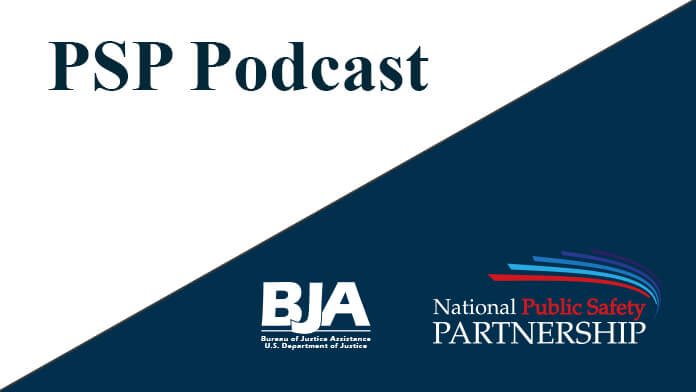
Child Sex Trafficking
Today’s law enforcement is increasingly tasked with dealing with children who are exposed to violence, crime, and abuse. Unfortunately, one of the most horrific crimes against children is sex trafficking. The child sex trafficking industry can reach beyond the borders of the United States and it can be as close to you as next door, in your neighborhood. The consequences of this high-dollar exploitation of children are far-reaching and result in an uncertain future for its victims—physically, mentally, and socially. The U.S. Department of Justice’s National Public Safety Partnership (PSP) is pleased to host Ms. Cynthia Pappas in this podcast on child sex trafficking and available resources. Ms. Pappas is a senior policy advisor for the U.S. Department of Justice, Office of Juvenile Justice and Delinquency Prevention, where she provides national leadership and coordination on issues surrounding child sexual abuse, child sex trafficking prevention and intervention, and youth and law enforcement engagement.

Children Exposed to Violence in Law Enforcement
Today’s law enforcement officers are increasingly tasked with dealing with children who are exposed to violence, crime, and abuse. If not the victim, children witness the victimization of others and the resulting trauma, which if left unaddressed, can have far-reaching effects and result in an uncertain future for its victims. The U.S. Department of Justice’s VRN is pleased to host Ms. Cynthia Pappas in this podcast on Children Exposed to Violence. Ms. Pappas is a senior policy advisor for the U.S. Department of Justice, Office of Juvenile Justice and Delinquency Prevention (OJJDP), where she provides national leadership and coordination on issues surrounding child sexual abuse, child sex trafficking prevention and intervention, and youth and law enforcement engagement.

Privacy, Civil Rights, and Civil Liberties—Considerations for Law Enforcement
This podcast defines privacy, civil rights, and civil liberties and the role of law enforcement in the collection and sharing of information.
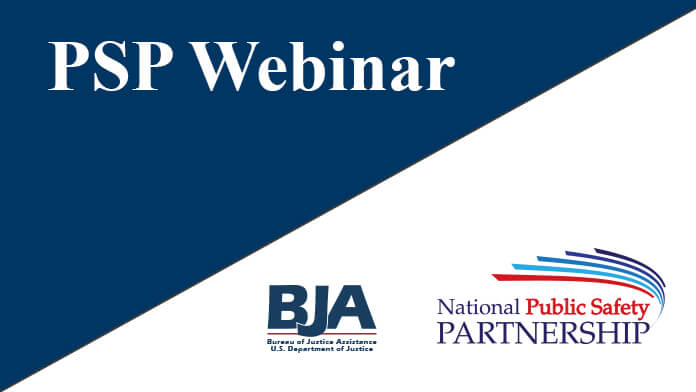
BJA Transition Update and Site Updates
The purpose of this webinar is for BJA to share information regarding VRN activities moving forward through the transition process and to highlight the VRN site resource delivery plans and sustainability efforts.
Please contact us for more information regarding this webinar.

Bureau of Alcohol, Tobacco, Firearms and Explosives (ATF) NIBIN and eTrace Overview
The Violence Reduction Network is pleased to present this podcast of the ATF National Integrated Ballistics Information Network (NIBIN) and the Electronic Tracing System (eTrace) networks. The focus of this podcast is to provide an overview of these resources and the services they provide to law enforcement.

License Plate Reader Best Practices
The purpose of this webinar is to provide law enforcement officials with an overview of the value of license plate readers (LPRs), including how to establish a program, the development of policies for LPR use, LPR successes, and the development of implementation plans.

Peer-to-Peer Webinar Roundtable on Sustainability
The focus of the webinar is to discuss sustainability of strategies and evidence-based practices learned and experienced through VRN. The webinar will serve as an opportunity for the 2014 sites to discuss sustainability plans, successes, and challenges with each other, based on their internal discussions.

Recruiting a Diverse Police Department Through Digital Outreach
A police department that reflects the ethnic, gender, and racial makeup of the communities it serves helps to build trust and improve relationships. Commitment to encouraging diversity in the police force has immense value, both internally and externally. This past winter, candidates were invited to apply to the Chicago Police Department for the first time in three years. Of the 14,000 applicants who responded to the announcement, 71 percent identified as a minority. Maintaining a police force that represents the community it serves is a top priority in Chicago and across the country. The webinar highlights the importance of diversity for building trust in the community and describes how Chicago developed a 12-week digital outreach campaign to bolster minority recruitment and lessons learned that will improve efforts in the future.

Exploring Active Shooter Response and Training
The goal of this webinar is to provide law enforcement officials with an overview of the research and analysis of active shooting incidents from the last several years and to share information regarding training strategies and best practices for law enforcement response to an active shooter. It will also provide information regarding current DOJ training and resources available through the FBI and the BJA VALOR Initiative and the Advanced Law Enforcement Rapid Response Training (ALERRT) Program.

Casualty Care and Rescue Tactics
“Today’s law enforcement officers are facing increasing threats from not only non-traditional events such as terrorist attacks and active shooter events but a continuation of traditional threats and assaults that occur during traffic stops, domestic disturbances and the like.” ~Chief David Flory (Ret.),
Being prepared with the necessary skills and knowledge to provide immediate life-saving aid to oneself as well as to an injured individual has never been more critical for law enforcement. The U.S. Department of Justice’s Violence Reduction Network (VRN) is pleased to host Chief David Flory (Ret.) in this podcast discussion on casualty care and rescue tactics, otherwise known as self-aid/buddy-aid.

Prosecution Strategies for Violence Reduction
In today’s environment, the role of the prosecutor in overall violence reduction extends far beyond the courtroom. Across the country, some communities have adopted unique and multifaceted approaches to reducing violent crime by establishing trust and providing opportunities for success through community outreach, call-in sessions, and strong partnerships among the community, prosecutors, law enforcement, probation and parole, academia, and social services. Join this webinar to learn about two innovative, data-driven programs and the benefit of prosecutorial involvement in violence reduction strategies for the communities they serve.

Social Media Analysis
Social media plays a valuable role in allowing people, businesses, and organizations to keep in touch and interact with one another in ways as never before. Unfortunately, social media can also be used by individuals to espouse criminal intentions, coordinate criminal activities, and even publicize acts of violence. This webinar orients the audience with tools, methods, and techniques to search for subjects, issues, or people on any number of social media sites. Participants also generate a more complete understanding of the concept and function of these sites, how some sites support analysis while others support targeting, and how social media tools and resources can be used to prevent, mitigate, respond to, and investigate criminal activity. By forming a more complete understanding of social media-associated investigative tools and techniques, law enforcement may be better equipped to gather timely information in the furtherance of crime prevention and the investigation of criminal activity.

Resources for Victim Service Providers Involved in VRN
Effective training is essential to providing quality victim services. Victims and survivors interact with various criminal justice system professionals at different points in the criminal justice process and may have evolving needs specific to victimization and population types. The Office for Victims of Crime Training and Technical Assistance Center (OVC TTAC) offers a wide variety of support services that can be tailored to meet the needs of individual VRN sites. During this webinar, viewers learn how OVC TTAC is supporting the Wilmington VRN site with training and technical assistance and how to request training and technical assistance for victim service providers and allied professionals in your site.

Strategies to Improve Homicide Investigations and Increase Clearance Rates
During this webinar, participants heard from Dr. David Carter and Mr. Brian Russell on successful and effective approaches in managing homicide investigations based on the collective experience of seven law enforcement agencies, the importance of a reciprocal relationship between law enforcement and prosecutors, and the critical tasks during the first 48 hours of a homicide investigation.

Utilizing Social Network Analysis to Reduce Violent Crime
The growing field of network science examines how our social connections influence a range of phenomena, including whom we marry, the things we buy, the votes we cast, the jobs we get, and even the health of our communities and families. This webinar explored how social network analysis (SNA) can be used to understand and guide gun violence prevention efforts. The webinar covered the basics of SNA, with the aim of providing a foundation for understanding how mapping human social networks can be used to better address violent crime. Geared towards participants from all areas of the criminal justice community, the webinar addressed the key concepts and the basic data and computing requirements for effective social network analysis. This webinar focused on the use of law enforcement agency record information to examine social ties, such as when suspects are arrested together or are linked together for having been mentioned in the same field interview stop. These official ties were used to illustrate the utility of SNA.

Virtual Forum
The U.S. Department of Justice hosted the VRN Virtual Forum as a collective Network update for all VRN sites and DOJ. This forum provided an opportunity for VRN site leaders and representatives to hear from each other regarding violence reduction efforts under way in each site and the DOJ resources that have been most helpful to them. Sites provided feedback on assistance that has been delivered through VRN, goals for the next six months, and ways VRN can better assist in the future. The VRN leadership team also provided a briefing on the future of the Network, including new sites, the fall summit, and more.

Strategies to Address Witness Intimidation
Intimidation of witnesses can be a significant challenge for violence reduction efforts because it infringes upon the effective and fair operation of the judicial process. Without cooperating witnesses, police investigators and prosecutors are denied critical evidence, cases are jeopardized, and confidence in the criminal justice system’s ability to protect and represent the members of the community is undermined. During this webinar, participants heard from subject-matter experts regarding innovative ways to address witness intimidation. Ms. Kristine Hamann, BJA Visiting Fellow, provided opening remarks and facilitated the discussion among nationally recognized subject-matter experts regarding their expertise in implementing effective strategies to protect witnesses.

Top Offender Lists
With research indicating that a relatively small number of offenders are responsible for a large number of the crimes that are committed, identifying top offenders for the targeting of scarce resources can be a successful strategy to address and decrease crime in the community. The objectives of this session were to learn how to develop and maintain a top offender list, discuss strategies and related challenges and prospects to using a top offender list, learn about the lists developed by different agencies and initiatives, and discuss the utilization of top offender lists with your VRN colleagues.